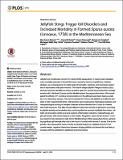Por favor, use este identificador para citar o enlazar a este item:
http://hdl.handle.net/10261/133150COMPARTIR / EXPORTAR:
 SHARE SHARE
 CORE
BASE CORE
BASE
|
|
| Visualizar otros formatos: MARC | Dublin Core | RDF | ORE | MODS | METS | DIDL | DATACITE | |

| Título: | Jellyfish Stings Trigger Gill Disorders and Increased Mortality in Farmed Sparusaurata (Linnaeus, 1758) in the Mediterranean Sea |
Autor: | Bosch Belmar, Mar CSIC ORCID; M’Rabet, Charaf; Dhaouadi, Raouf; Chalghaf, Mohamed; Nejib Daly Yahia, Mohamed; Fuentes, Veronica CSIC ORCID; Piraino, Stefano; Kéfi-Daly Yahia, Ons | Fecha de publicación: | abr-2016 | Editor: | Public Library of Science | Citación: | PLoS ONE 11(4): e0154239 (2016) | Resumen: | Jellyfish are of particular concern for marine finfish aquaculture. In recent years repeated mass mortality episodes of farmed fish were caused by blooms of gelatinous cnidarian stingers, as a consequence of a wide range of hemolytic, cytotoxic, and neurotoxic properties of associated cnidocytes venoms. The mauve stinger jellyfish Pelagia noctiluca (Scyphozoa) has been identified as direct causative agent for several documented fish mortality events both in Northern Europe and the Mediterranean Sea aquaculture farms. We investigated the effects of P. noctiluca envenomations on the gilthead sea bream Sparus aurata by in vivo laboratory assays. Fish were incubated for 8 hours with jellyfish at 3 different densities in 300 l experimental tanks. Gill disorders were assessed by histological analyses and histopathological scoring of samples collected at time intervals from 3 hours to 4 weeks after initial exposure. Fish gills showed different extent and severity of gill lesions according to jellyfish density and incubation time, and long after the removal of jellyfish from tanks. Jellyfish envenomation elicits local and systemic inflammation reactions, histopathology and gill cell toxicity, with severe impacts on fish health. Altogether, these results shows P. noctiluca swarms may represent a high risk for Mediterranean finfish aquaculture farms, generating significant gill damage after only a few hours of contact with farmed S. aurata. Due to the growth of the aquaculture sector and the increased frequency of jellyfish blooms in the coastal waters, negative interactions between stinging jellyfish and farmed fish are likely to increase with the potential for significant economic losses | Descripción: | 11 pages, 4 figures | Versión del editor: | https://dx.doi.org/10.1371/journal.pone.0154239 | URI: | http://hdl.handle.net/10261/133150 | DOI: | 10.1371/journal.pone.0154239 | Identificadores: | doi: 10.1371/journal.pone.0154239 issn: 1932-6203 e-issn: 1932-6203 |
| Aparece en las colecciones: | (ICM) Artículos |
Ficheros en este ítem:
| Fichero | Descripción | Tamaño | Formato | |
|---|---|---|---|---|
| Bosch_et_al_2016.PDF | 2,05 MB | Adobe PDF |  Visualizar/Abrir |
CORE Recommender
PubMed Central
Citations
6
checked on 26-mar-2024
SCOPUSTM
Citations
27
checked on 17-abr-2024
WEB OF SCIENCETM
Citations
24
checked on 29-feb-2024
Page view(s)
254
checked on 22-abr-2024
Download(s)
170
checked on 22-abr-2024
Google ScholarTM
Check
Altmetric
Altmetric
Artículos relacionados:
NOTA: Los ítems de Digital.CSIC están protegidos por copyright, con todos los derechos reservados, a menos que se indique lo contrario.
